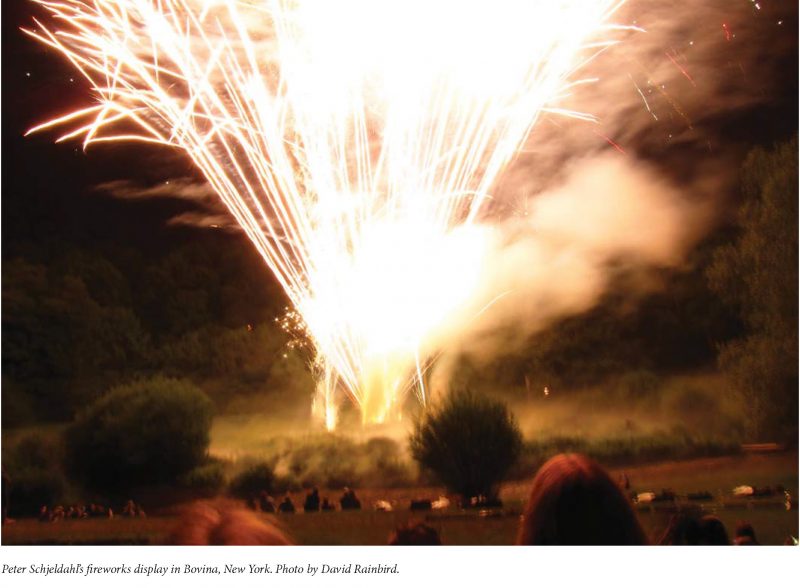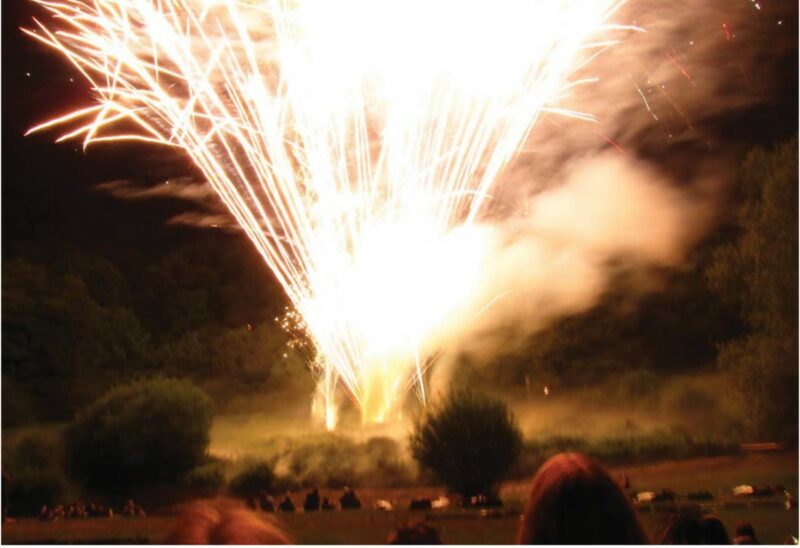This Fourth of July, on a ridgeline in remote Upstate New York, Peter Schjeldahl is going to blow stuff up. Schjeldahl is the New Yorker’s erudite longtime art critic. Never a pontificator, he’s the sort of writer who brings you in close enough to see art as he sees it. He’s also a serious pyromaniac. So every year, along with his wife, antiques dealer Brooke Alderson, he throws a party in his backyard in the town of Bovina, New York. Backyard might be too tame a word for the setting, which features a meadow, forest, stream, and mountain, all of which Schjeldahl takes into consideration as he plans his yearly display. The crowd is equal parts art-world folks and good old boys, locals from the volunteer fire department and downstaters. In contrast to the spectacle, Peter himself is shy, nebbishy, and tweedy—a poet and a stickler. And he’s great at blowing shit up. We talked just after he’d had dental surgery, and when he describes the process of wiring trees with explosives, his voice rises.
—Jennifer Kabat
Peter Schjeldahl’s annual Fourth of July fireworks display
THE BELIEVER: Your fireworks are majestic and terrifying. It’s like you bring them back to something essential, something I’ve never seen before in a fireworks display.
PETER SCHJELDAHL: My if-in-doubt first principle has always been to set off everything as fast as I can. One second of dead time between fireworks is an eternity. It’s evolved over twenty-five years, and the show’s co-author is the landscape. Brooke and I are blessed with this perfect piece of land that has a natural proscenium and great depth and different zones.
BLVR: How did you start to read the land like that and see its potential for blowing stuff up?
PS: Sort of like a giant fire garden? Brooke, who’s a great garden-maker, helped me see how the parts fit together. The development of the show was through trial and error and error and error. I’m completely self-taught, and in the first decade or so it’s a miracle nobody got seriously hurt. It was crazy. Now it should seem crazy. My ideal is intensity. People, including professionals, think of the beauty of fireworks. I regard the results of that as academic art.
BLVR: All the municipal displays I’ve seen are so predictable, even the federal government one, on the National Mall, in Washington, DC.
PS: They’re all just sky painting. No matter where they are in terms of distance, you read them in one plane. People fuss with all these fancy shells, seeking beauty, which is stupid. Fireworks can’t help but be beautiful. Let that take care of itself. Go for intensity.
BLVR: And sometimes people get scared.
PS: Yes, terror! Which, if nothing bad happens, becomes delight. And surprise. Surprise is intense. Instead of sky painting, I think of the show as sculptural. Describing this is strange. Anything I say is from the vantage of retrospect. I never understand what I’m doing when I first try it. So here I am being the knowledgeable critic of a doofus. But I believe now that I’ve dealt with a problem of landscape painting. The classic difficulty is middle ground. There’s foreground and the deep background, then there’s this little horizontal slice of canvas that you have to convince us is one hundred yards or half a mile across in depth. Poussin worked it out in one way, van Gogh in another. Our land gives us that middle-ground meadow, which I fire things across at low angles. Among my inspirations is a story that Dave Hickey tells about being in Las Vegas when Steve Wynn inaugurated the fountains at the Bellagio, and his guest of honor was Robert Rauschenberg. At the end of the show Steve Wynn turned to Rauschenberg and said, “What do you think, Bob?” And Rauschenberg said, “Why does everything always have to go up?” I seize on every possible way to have stuff go sideways and back and forth.
BLVR: It can look like a pitched battle—things shooting across the field at each other.
PS: There’s that, but formally it’s about establishing the recession from near to far, and vice versa. The near stuff does go up, or else it might hit the audience; I have the live firing line there, of brave and skillful old hands lately captained by Gerry Marzorati. You see things being set off right in front of you by people scrambling around in an inferno. Everything across the stream is wired. It’s me and Scott Hill up in the woods: me calling the cues and Scott pushing buttons. Besides the stuff in the meadow and in the low woods on the mountain, there’s the upper forest, which didn’t perform as planned last year. It was supposed to look like the top of the mountain blew off. There was a loose wire. We’ll try to get it right this year.
BLVR: Speaking of the mountain and meadow, how did you first decide to backlight that tree?
PS: It’s not backlit. The tree is loaded. The stuff is being fired from inside it.
BLVR: Isn’t that risky?
PS: Not in the least. People from the city always think we’re going to start a forest fire, but they don’t realize how moist Delaware County is and that fireworks aren’t fire. They’re sparks, and without dry tinder nothing is going to catch. I got the tree idea on Millennium Eve. On television I saw the fireworks at the Eiffel Tower, which was loaded up with, it seemed, tens of thousands of charges. Later I asked my fireworks guy in Pennsylvania, “Did you see that, did you see the Eiffel Tower?” He said, “Fucking French.” He was bitter at their superiority. I don’t have an Eiffel Tower. But I’ve got a lot of trees. So I started duct-taping stuff into them to fire up and out and even down, or aimed to bounce around in the branches.
BLVR: And every year your fireworks guy gives you stuff to try?
PS: He always slips me a couple dozen new things as free samples. Some are very large. Then of an evening I’ll test them with some of my crew. We all have report cards and we rate them.
BLVR: I remember seeing that one Memorial Day, only the fireworks looked like standard fireworks.
PS: Just testing. By the way, I’m not terribly selective about what the things are. I like variety, but my main principle is quantity. Enough of anything is fantastic and too much is sublime.
BLVR: But something happened between that Memorial Day and the Fourth. It’s like in your hands they go through this process of translation.
PS: It’s multiplication. If I like some particular thing, I’ll get six or eight of them and set them all off at once, with other things. I want to overwhelm. My memories of joy in fireworks—as in theater, as in most things—involve a feeling of being overwhelmed, and I want to share that.
BLVR: Now people look at it as your art, however cheesy that sounds.
PS: People say that, and I’ve felt I had to guard against it, not to get precious or pretentious. The first time Roberta Smith came she was talking to me by the bonfire afterward, making erudite references to Chinese scroll painting, and I had a flash that this is how artists feel when I talk to them. I had two thoughts: one, that I was so glad she liked it, and, two, that I didn’t know what the fuck she was talking about. But maybe by now I’m secure enough in the basic indispensable dumbness of setting off fireworks to entertain a fancy notion or two. A few years ago, for the first time, Brooke and I went to a Wagner opera, Tristan und Isolde. It was a revelation. I’ve since seen seven of his operas and discovered that my sense of his music was all wrong. People call it bombastic. It’s not. It’s incredibly subtle. In Tristan, it keeps approaching climaxes but not climaxing. It shifts sideways into something else and then at the end tries to shift again, and there’s nothing. It’s over. Before that I had a habit of using dramatic pauses and big finales. Wagner showed me that that was cheap. The show should be absolutely flowing, one thing complementing or contradicting another. Any pause is because something didn’t go off, and usually something doesn’t.
BLVR: But no one notices.

PS: There’s no way you can fuck up with fireworks that someone won’t think is a stroke of genius. It’s pretty hard not to impress people with fireworks. It’s a very forgiving medium, if you trust the first principle of setting everything off as fast as possible.
BLVR: I think beyond making things go boom, the Fourth of July means something to you.
PS: Yeah, I’m a patriot. It’s the birthday of the country, and such a great story. We kicked King George’s ass. By the way, I don’t regard patriotism as conservative.
BLVR: One of the things I love about the fireworks is everyone singing “The Star-Spangled Banner” at the start.
PS: For me, American patriotism is being loyally devoted to something that’s always changing and never defined. The one thing that doesn’t change about America is that it keeps changing. The natural tendency for a continent as heterogeneous as North America is to break up into different countries, like the Balkans. We tried that once and it was such a nightmare we won’t do it again. Anyhow, it’s inevitable that the symbols we can all share will be fairly crude. Any more refined and you’ve got an argument. The Fourth is this annual reset, to touch some nerve of whatever it is that we have in common just by being citizens. If you rejected that, where would you be? What would you be?





